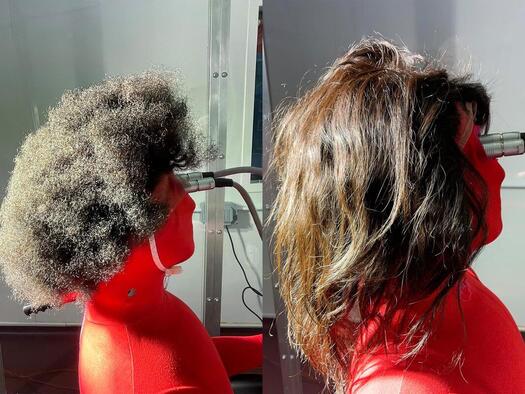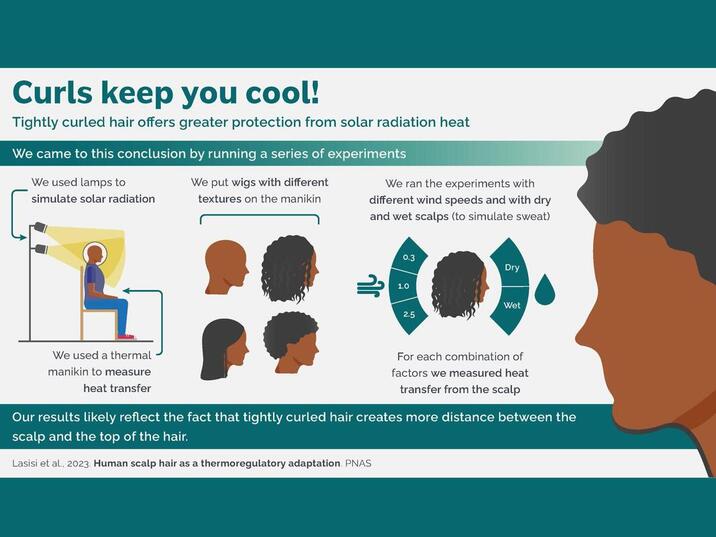|
Tightly curled scalp hair protected early humans from the sun’s radiative heat, allowing their brains to grow to sizes comparable to those of modern humans. Curly hair does more than simply look good — it may explain how early humans stayed cool while conserving water, according to researchers who studied the role human hair textures play in regulating body temperature. The findings can shed light on an evolutionary adaptation that enabled the human brain to grow to modern-day sizes. “Humans evolved in equatorial Africa, where the sun is overhead for much of the day, year in and year out,” said Nina Jablonski, Evan Pugh University Professor of Anthropology at Penn State. “Here the scalp and top of the head receive far more constant levels of intense solar radiation as heat. We wanted to understand how that affected the evolution of our hair. We found that tightly curled hair allowed humans to stay cool and actually conserve water.” The researchers used a thermal manikin — a human-shaped model that uses electric power to simulate body heat and allows scientists to study heat transfer between human skin and the environment — and human-hair wigs to examine how diverse hair textures affect heat gain from solar radiation. The scientists programmed the manikin to maintain a constant surface temperature of 95 degrees Fahrenheit (35 degrees Celsius), similar to the average surface temperature of skin, and set it in a climate-controlled wind tunnel.  A thermal manikin wearing tightly curled (left) and straight (right) human hair wigs. The manikin uses electric power to simulate body heat and allows scientists to study heat transfer between human skin and the environment. A new study examining the role human hair textures play in regulating body temperature found that tightly curled hair provides the best protection from the sun’s radiative heat while minimizing the need to sweat to stay cool. Credit: George Havenith, Loughborough University. All Rights Reserved. The team took base measurements of body heat loss by monitoring the amount of electricity required by the manikin to maintain a constant temperature. Then they shined lamps on the manikin’s head to mimic solar radiation under four scalp hair conditions — none, straight, moderately curled and tightly curled. The scientists calculated the difference in total heat loss between the lamp measurements and the base measurements to determine the influx of solar radiation to the head, explained George Havenith, director of the Environmental Ergonomics Research Centre at Loughborough University, U.K., who led the manikin experiments. They also calculated heat loss at different windspeeds and after wetting the scalp to simulate sweating. They ran their results through a model to study how the diverse hair textures would affect heat gain in 86-degree Fahrenheit (30 degrees Celsius) heat and 60% relative humidity, like environments in equatorial Africa. The researchers found that all hair reduced solar radiation to the scalp, but tightly curled hair provided the best protection from the sun’s radiative heat while minimizing the need to sweat to stay cool. They reported their findings yesterday (June 6) in the Proceedings of the National Academy of Sciences. “Walking upright is the setup and brain growth is the payoff of scalp hair,” said Tina Lasisi, who conducted the study as part of her doctoral dissertation at Penn State. Lasisi will start as an assistant professor of anthropology at the University of Michigan in the fall. As early humans evolved to walk upright in equatorial Africa, the tops of their heads increasingly took the brunt of solar radiation, explained Lasisi. The brain is sensitive to heat, and it generates heat, especially the larger it grows. Too much heat can lead to dangerous conditions like heat stroke. As humans lost much of their body hair, they developed efficient sweat glands to keep cool, but sweating comes at a cost in lost water and electrolytes. Scalp hair likely evolved as a way to reduce the amount of heat gain from solar radiation, thereby keeping humans cool without the body having to expend extra resources, said Lasisi. “Around 2 million years ago we see Homo erectus, which had the same physical build as us but a smaller brain size,” she said. “And by 1 million years ago, we’re basically at modern-day brain sizes, give or take. Something released a physical constraint that allowed our brains to grow. We think scalp hair provided a passive mechanism to reduce the amount of heat gained from solar radiation that our sweat glands couldn’t.” The multidisciplinary research provides important preliminary results for bettering our understanding of how human hair evolved without putting humans in potentially dangerous situations, said Jablonski. The study also shows that evolutionary anthropologists have an extra tool in the thermal manikin – normally used for testing the functionality of protective clothing – for quantifying human data that is otherwise very difficult to capture, added Havenith. “The work that’s been done on skin color and how melanin protects us from solar radiation can shape some of the decisions that a person makes in terms of the amount of sunscreen needed in certain environments,” said Lasisi. “I imagine that similar decision making can occur with hair. When you think about the military or different athletes exercising in diverse environments, our findings give you a moment to reflect and think: is this hairstyle going to make me overheat more easily? Is this the way that I should optimally wear my hair?” Also contributing to the research were James Smallcombe, Loughborough University and the University of Australia; and from Penn State Larry Kenney, professor of physiology, kinesiology and Marie Underhill Noll Chair in Human Performance; Mark Shriver, professor of anthropology; and Benjamin Zydney, previously an undergraduate research assistant and now a Penn State alum. The National Science Foundation and the Wenner-Gren Foundation supported this work. from PennStateEdu
Hair by Brian - The Beauty Blog
Comments are closed.
|
Hair by BrianMy name is Brian and I help people confidently take on the world. CategoriesAll Advice Announcement Awards Balayage Barbering Beach Waves Beauty News Book Now Brazilian Treatment Clients Cool Facts COVID 19 Health COVID 19 Update Curlies EGift Card Films Follically Challenged Gossip Grooming Hair Care Haircolor Haircut Hair Facts Hair History Hair Loss Hair Styling Hair Tips Hair Tools Health Health And Safety Healthy Hair Highlights Holidays Humor Mens Hair Men's Long Hair Newsletter Ombre Policies Procedures Press Release Previous Blog Privacy Policy Product Knowledge Product Reviews Promotions Read Your Labels Recommendations Reviews Scalp Health Science Services Smoothing Treatments Social Media Summer Hair Tips Textured Hair Thinning Hair Travel Tips Trending Wellness Womens Hair Archives
July 2025
|
|
Hey...
Your Mom Called! Book today! |
Sunday: 11am-5pm
Monday: 11am-6pm Tuesday: 10am - 6pm Wednesday: 10am - 6pm Thursday: Closed Friday: Closed Saturday: Closed |


 RSS Feed
RSS Feed